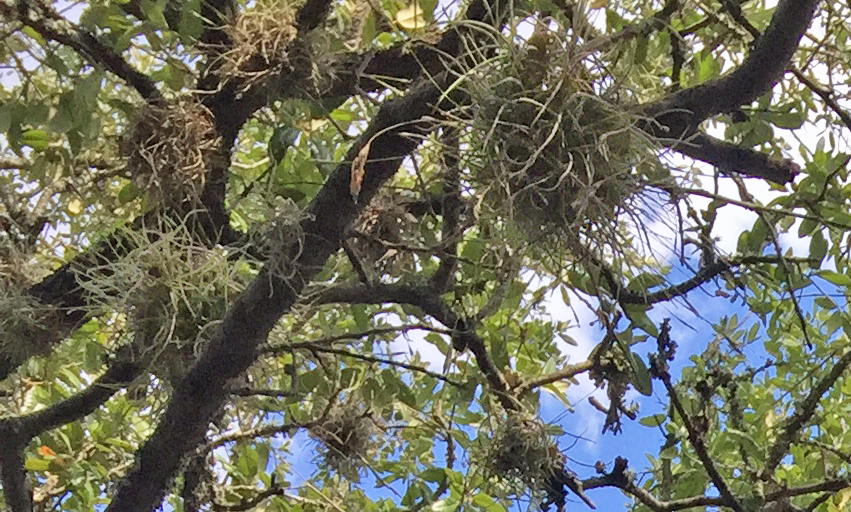Ball Moss is a flowering plant (not a moss at all!) that has been given a bad rap by many people in Central Texas. We have customers frequently ask how to “kill” the moss in their trees, as they believe it is harmful to the tree. Well, I’m going to give you the real scoop on this often misunderstood plant.
It’s not hard to believe that the native Ball Moss is related to our popular “Air Plants”, which are sold as house plants. Both belong to the Genus Tillandsia. They are classified as Epiphytes, plants which use trees, electric wires, fence posts, or other objects as support while neither taking nor giving anything to the tree or structure it is growing on. Ball Moss photosynthesizes its own food in its leaves, absorbing water and nitrogen from the air. It does not root into the tree, but does produce “holdfasts” which serve to attach the plant to the tree or structure. Ecologically, the Ball Moss provides habitat for insects and is beneficial to the birds and other small animals which feed on the insects.
Ball Moss matures in about 3 years, then will bloom and disseminate seed for about 6-7 years. Each flower can produce up to 100 seeds, with as many as 50 flowers in a mature clump of Ball Moss. As the wind blows over the top of the tree, the seeds are carried up with the updraft that forms and are deposited on the tree limbs as they fall. Ball Moss is found mostly on the lower limbs because of the way that the seed is disseminated, and also because it benefits from more shade and higher humidity in that location. This is where the false belief that the Ball Moss has killed the lower limbs comes in. As trees such as Oaks grow, they shade out their lower limbs and the leaves and branches die from lack of light. This is a natural process. The dissemination of Ball Moss seed and the ideal growing conditions in the lower canopy make it appear that the Ball Moss has done harm to the tree. BUT THIS IS NOT THE CASE!
Controlling Ball Moss is not easy. However, trees that are pruned correctly on a regular basis seldom accumulate Ball Moss. Neglected trees, such as those out in a pasture, will naturally accumulate Ball Moss on the lower limbs, as the dead wood is seldom removed. You will often see dead limbs that have fallen, with irregular breakage points on the tree. These breakage points are ideal for insects and disease to enter. It is important for tree health to remove dead limbs with pruning cuts made at the appropriate location. This allows the tree to compartmentalize any disease and heal over the wound. Done on a regular basis, Ball Moss is removed with these dead limbs and is less likely to have a chance to re-establish between prunings. Ball Moss may also be removed manually. Just remember when working on Live Oak species to avoid removal from February through June when the Nitidulid beetle is active, as knocking the Moss out of the tree may cause an open wound for the beetle to infect the tree with the Oak Wilt Fungus.
Trees located near bodies of water will generally have more Ball Moss, as it benefits from the increased relative humidity. In areas with severe Ball Moss infestation, it may actually grow over the ends of limbs, causing the branches to be shaded out and killing the leaves in the outer canopy. These trees need to have the moss pruned out or perhaps even sprayed to kill the Ball Moss.
Spraying to eradicate Ball Moss is not a very satisfying experience. Seed from neighboring trees will quickly re-infest the tree, and the Ball Moss, when killed, will not fall off the tree until the holdfasts have rotted, which could take anywhere between 18 months to 8-10 years!
There are sprays are available to use on Ball Moss, but should only be sprayed under extreme circumstances. They should be sprayed in early spring (February-April) and repeated in 12 months if re-infestation occurs.
Sodium bicarbonate, or baking (50 lbs. to 100 gallons of water) may be used, but must be mixed thoroughly (agitated) and must thoroughly saturate the Ball Moss. Remember, the Ball Moss will not drop from the tree for some time, even though it is dead.
Copper Hydroxide (Kocide) at a rate of 4-6 lbs. per 100 gallons of water, must also must thoroughly saturate the Ball Moss. The plants are desiccated by the chemical salts in these products, and will turn dark gray in color but will not fall off when they die. There is evidence that a copper based herbicide and fungicide has be shown to cause damage to tender growth on oaks, so hiring a professional to spray is recommended.
I hope this has answered any questions you might have about Ball Moss. Remember, it is NOT the cause of tree limbs dying! Trim your trees the RIGHT way, on a regular schedule, and Ball Moss will not be an issue.
